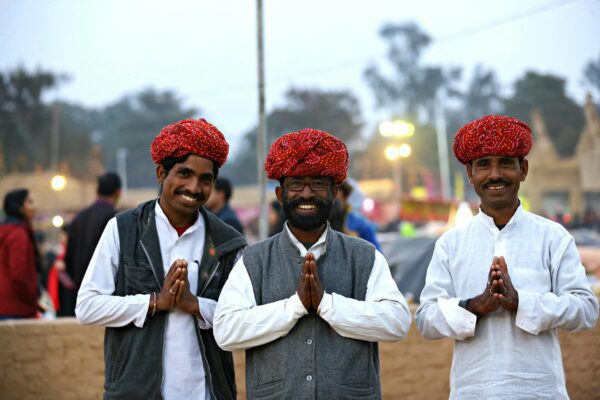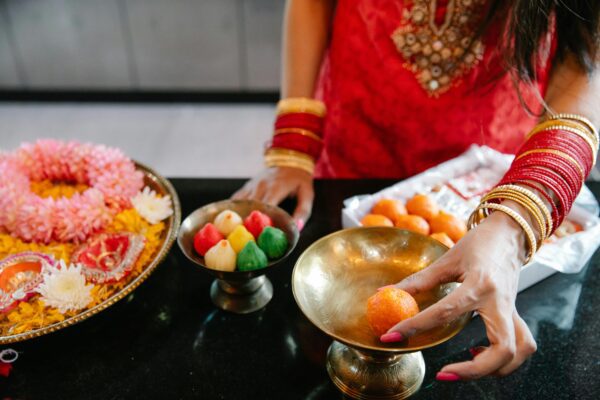Table of Contents

When planning a visit to India, immersing yourself in Indian culture can significantly enhance your travel experience. India is a vast, diverse country where tradition, history, and modernity coexist in a unique blend. To truly appreciate the beauty and complexity of this nation, understanding Indian culture is essential. From daily greetings to temple rituals, every aspect of life in India is steeped in customs that have been followed for centuries. By embracing these practices, travelers can show respect and connect more deeply with the locals. This guide, filled with India cultural etiquette tips for travelers, offers a clear overview of what you should know before stepping foot in this enchanting land.
Greetings and Respect: The Significance of Namaste
One of the first things travelers will notice when exploring Indian culture is the traditional greeting, “Namaste.” This gesture, which involves pressing the palms together with a slight bow of the head, signifies respect and humility. In many parts of India, especially in more traditional settings, shaking hands may not be common, particularly between men and women.
Adapting to this cultural norm helps convey your sensitivity and appreciation of local customs. In professional settings, a handshake is often acceptable, but it’s always best to let the local person initiate it. Using respectful language and referring to elders with appropriate titles like “ji” can also make a positive impression. These small yet meaningful acts of respect form a fundamental part of cultural etiquette in Indian society and are highly valued by locals across regions.
Dress Code: Modesty as a Cultural Value
Dressing modestly is a core component of Indian culture. In urban areas, you might see more western-style clothing, but traditional attire is still preferred, especially in rural regions and religious places. Women are advised to wear outfits that cover their shoulders and knees, such as kurtas with leggings or long skirts. Men usually wear trousers and shirts, with shorts being less common except at beach destinations.
Visiting temples and mosques requires even more modesty: shoulders and legs must be covered, and in some places, visitors are expected to cover their heads. Removing shoes before entering someone’s home or a place of worship is also customary. Dressing appropriately not only reflects cultural sensitivity but also helps travelers feel more comfortable and accepted within local communities.

Eating Habits: Table Manners and Shared Meals
Indian culture places significant emphasis on food and hospitality. Meals are often enjoyed with family, and sharing food is seen as a gesture of bonding and respect. One important etiquette tip is to eat with your right hand, as the left hand is traditionally considered unclean. In formal settings or rural homes, washing hands before and after meals is customary.
If invited to someone’s home, it is polite to accept at least a small portion of each dish offered. Refusing food outright may be considered disrespectful. Saying “thank you” after a meal, while appreciated, is less common than in the West; instead, a compliment about the meal is more warmly received. Understanding these mealtime etiquettes is a key part of India cultural etiquette tips for travelers and ensures a more respectful and enjoyable dining experience.
Temple Visits and Religious Observances
Religion plays a central role in Indian culture, with Hinduism, Islam, Christianity, Sikhism, Buddhism, and Jainism all contributing to the country’s spiritual diversity. When visiting temples or other religious sites, it is important to follow specific etiquette rules. Dress conservatively, remove your shoes before entering, and avoid taking photos unless explicitly permitted. In Hindu temples, non-Hindus may be restricted from entering the inner sanctum.
Offering donations, lighting incense, or participating in rituals is generally welcome but should be done respectfully. Avoid touching idols or sacred objects unless guided to do so. Speaking softly and refraining from public displays of affection within religious premises also reflects good manners. Respect for these practices demonstrates a traveler’s understanding of Indian culture and enriches their spiritual encounters during the journey.
Gender Interactions and Social Norms
Understanding gender roles and interactions is vital when navigating Indian culture. While urban areas have embraced modern attitudes, traditional gender norms are still prevalent in many parts of the country. Public displays of affection, such as hugging or kissing, are generally frowned upon, especially in rural or conservative communities. It’s advisable to maintain a polite physical distance when interacting with the opposite sex.
When addressing women, a respectful tone and non-intrusive behavior are expected. In situations where you are unsure about appropriate behavior, observing locals can offer helpful cues. Solo female travelers may also consider dressing modestly and avoiding isolated areas after dark. Adhering to these India cultural etiquette tips for travelers helps ensure safe and respectful interactions, fostering mutual understanding and trust.

Transportation and Public Behavior
Public transportation in India, including buses, auto-rickshaws, and trains, can be crowded and overwhelming for first-time visitors. Patience and politeness go a long way. Giving up your seat to the elderly or women, avoiding loud conversations, and respecting personal space (as much as possible) are all considered good manners. When hailing taxis or auto-rickshaws, it’s customary to negotiate or confirm the fare in advance to avoid confusion.
In metros and local trains, look for women-only compartments if you prefer gender-segregated spaces. Standing in queues, even if loosely formed, and waiting your turn shows cultural awareness. Simple acts like thanking drivers, not littering, and offering small tips for good service reflect positively on you as a traveler and align with broader expectations of courtesy in Indian culture.
Festivals, Celebrations, and Invitations
India is a land of festivals, and each celebration offers a glimpse into the heart of Indian culture. From Diwali and Holi to Eid, Christmas, and Pongal, festivals are celebrated with immense enthusiasm. If invited to a celebration, consider it an honor and a chance to engage deeply with Indian traditions. Wearing festive attire, bringing a small gift, and participating with an open mind are great ways to show appreciation.
Always inquire about any specific customs or rituals you should be aware of. While photography is usually welcome, ask before capturing private family moments. Accepting food, joining dances, or simply listening to stories shared by your hosts enriches your experience. These moments are more than just entertainment—they’re vibrant expressions of cultural heritage and shared joy.
Environmental Etiquette and Responsible Tourism
With its natural beauty and bustling cities, India offers diverse travel experiences. Yet, with these opportunities comes the responsibility to practice environmentally respectful behavior. Indian culture emphasizes harmony with nature—a concept found in traditional practices and religious teachings. Avoid littering, conserve water, and respect wildlife and natural habitats. In many regions, using plastic bags is banned, so carry reusable alternatives.
When trekking or visiting eco-sensitive areas, follow local guidelines and leave no trace. Respecting the environment also means being mindful of noise levels and pollution. Supporting local artisans, choosing eco-friendly accommodations, and using public transport when possible align with sustainable tourism principles. These practices show reverence for Indian culture and contribute to preserving the country’s beauty for future generations.

Tipping, Bargaining, and Money Matters
Handling money with sensitivity is another aspect of Indian culture that travelers should be aware of. Tipping is common in restaurants, hotels, and for personal services like guides or drivers. While not obligatory, a 5-10% tip is appreciated in most cases. Bargaining is a common practice in local markets, and doing so politely is part of the cultural experience.
The key is to be respectful and not overly aggressive. When entering someone’s shop or stall, a smile and friendly tone go a long way. Avoid flaunting wealth or making excessive comparisons with your home country—such behavior can seem disrespectful. Exchanging money at authorized centers and carrying small change for everyday purchases ensures smooth transactions. Understanding these money-related etiquettes helps travelers blend in and interact more thoughtfully within Indian society.
Embracing Indian Culture with Respect and Curiosity
Traveling through India is a journey of discovery, not just of breathtaking landscapes and historic monuments, but of a living, breathing culture that continues to evolve. Embracing Indian culture requires an open heart and a willingness to learn. By observing local customs, listening to stories, and asking respectful questions, travelers can gain a deeper understanding of the people and traditions that make India so unique.
The India cultural etiquette tips for travelers shared in this guide are meant to serve as a bridge between cultures, helping visitors engage meaningfully and respectfully. When you travel with curiosity and kindness, you become more than a tourist—you become part of the rich tapestry that is India. Let your journey be guided by empathy, and you will leave with not just souvenirs, but lifelong memories and genuine connections.
Frequently Asked Questions
1. What should I know about greetings in Indian culture?
In Indian culture, a respectful greeting like “Namaste” with hands pressed together is widely accepted. A handshake is common in urban areas, especially among men, but it’s always polite to follow the local lead.
2. Is it okay to wear Western clothes in India?
Yes, Western clothes are fine in major cities, but modesty is important. Avoid revealing attire, especially in rural areas and religious places. Covering shoulders and knees is generally appreciated.
3. How should I behave at temples or religious sites?
Always remove your shoes before entering temples. Dress conservatively, avoid touching idols, and follow any posted rules. Some temples may restrict entry to non-Hindus, so check beforehand.
4. Can I use my left hand while eating or giving things?
In Indian culture, the left hand is considered unclean. It’s best to use your right hand for eating, offering gifts, or handing over money, especially during formal interactions.
5. What is the proper etiquette for dining with locals?
Wait to be invited to start eating, use your right hand, and avoid wasting food. In some homes, it’s customary to wash your hands before and after the meal. Always show gratitude.
6. Is public display of affection acceptable in India?
Public affection like hugging or kissing is generally frowned upon in Indian society, especially in rural or traditional areas. A smile or nod is a more accepted form of acknowledgment.
7. How should I address elders or strangers?
Respect for elders is vital in Indian culture. Use respectful titles like “ji” or address people as “Uncle” or “Aunty” as a sign of politeness. Avoid using first names unless invited to.
8. Are there any taboos I should be aware of?
Yes. Avoid criticizing religion or politics, touching someone’s head, or pointing your feet at people or deities. Also, stepping over books or sacred items is considered disrespectful.
9. How do I behave during festivals or ceremonies?
Participate respectfully and ask before taking photos. Dress appropriately, be open to trying food and rituals, and always show interest and appreciation for the traditions you’re witnessing.
10. What should I keep in mind when visiting someone’s home in India?
Bring a small gift, remove your shoes before entering, and wait to be seated. Accept refreshments graciously, and don’t refuse food outright—it may be taken as impolite.



